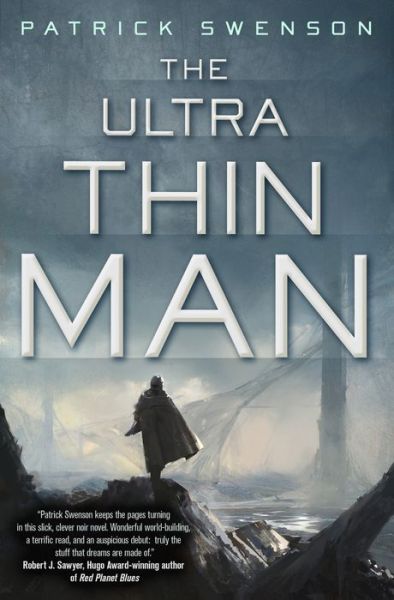 THIS REVIEW CONTAINS WHAT SOME MAY CONSIDER MINOR SPOILERS.
THIS REVIEW CONTAINS WHAT SOME MAY CONSIDER MINOR SPOILERS.
Blending elements of noir crime and science fiction isn’t a new thing, but Patrick Swenson in The Ultra Thin Man (Tor), tackles the mashup with enormous talent and verve. The author also throws in elements of the espionage thriller just so readers don’t get bored. Not that any will.
The story takes place in the twenty-second century, a future in which mortaline wire controls the weather on the settled planets and the entire populations of refugee camps are kept in a drug-induced slumber. When terrorists manage to crash Coral, the moon, into its home planet of Ribon, forcing evacuation, it’s up to Dave Crowell and Alan Brindos, contract detectives for the Network Intelligence Organization, to solve a case with massive implications.
The detectives are forced to head in different directions. Brindos has to hunt down the massive Helkunn alien Terl Plenko, shadow leader of the terrorist Movement of Worlds. Crowell, meanwhile, runs into an elaborate frame job that puts our heroes on the hook for treason.
Deep intrigue and an interstellar conspiracy are at work here. As is an all-important question: who, and what, is the Ultra Thin Man?
The Ultra Thin Man (a tribute to The Third Man, perhaps?) is informed by a Chandlerersque sensibility, with its short, crisp sentences and snappy one-liners. It also embraces some Dickian dystopian paranonia, complete with its own version of his replicants, in this case a plot to create a zombie army built with copies of refugees deliberately destroyed by the empire which seeks to erase humanity.
Alternating chapters give us the first person narrative of Crowell, and the third person of Brindos. Initially I could not understand the metronomic shift between first to third POVs. The reason for the device becomes clear later in the novel, though I still remain unconvinced that there was any real need for it.
The major scientific element is the concept of the ultra thin wire network as part of the planetary terraforming process. The wires create a stable atmosphere, among other things. But the technology has a more sinister aspect: the ability to replicate people. It transpires during the course of the tale that the last remaining cache of the precious metal is stored in a secure, secret location. The bad guys want it badly, and the good guys somehow have to stop them getting to it. The wire’s core material, mortaline, and the various uses to which it can be put, was an excellent hard science fiction idea, and convincingly established as the plot-driver.
Another thing the novel has in common with Chandler is this: some of the time you are clueless as to what’s going on. With all the body-hopping, plot twists, and the good guys becoming proving to be bad guys or visa versa, my poor brain could hardly cope. But then again, many a big name noir writer was equally guilty of this. It’s as though they, and Swenson, are saying: pay close attention, or you might miss something.
POV and plot confusions aside, my final words on the novel are overall positive ones. It’s truly a terrific read. In short, to paraphrase and modify Woody Allen’s definition of sex and apply it to the novel: “It’s the most fun you can have while still smiling.”
 Article by John Dodds John Dodds is the author of The Kendrick Chronicles crime novels (Bone Machines and Kali’s Kiss ) – the third novel in the series, Babylon Slide, is due out later in 2014. His YA steampunk superheroes novel, The Mechanikals, is out now for Kindle.
Article by John Dodds John Dodds is the author of The Kendrick Chronicles crime novels (Bone Machines and Kali’s Kiss ) – the third novel in the series, Babylon Slide, is due out later in 2014. His YA steampunk superheroes novel, The Mechanikals, is out now for Kindle.
Subscribe to Adventures in SciFi Publishing podcast on: iTunes | Stitcher Radio (Android users) | RSS | Website RSS |

















Speak Your Mind